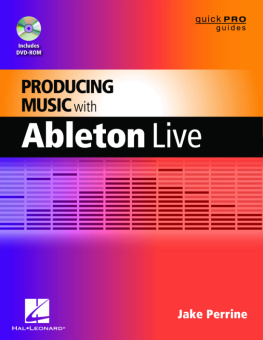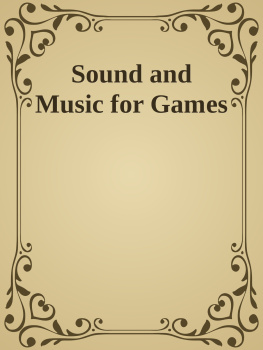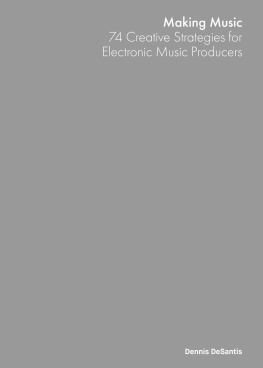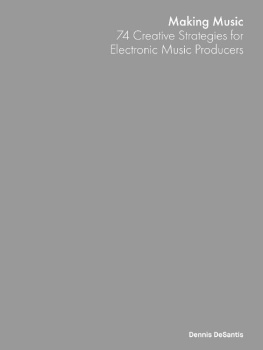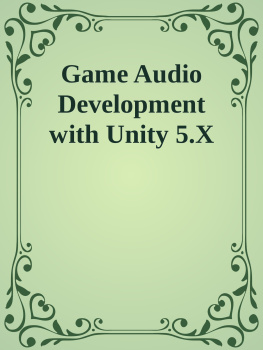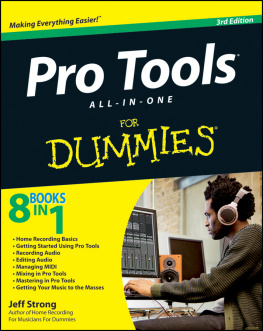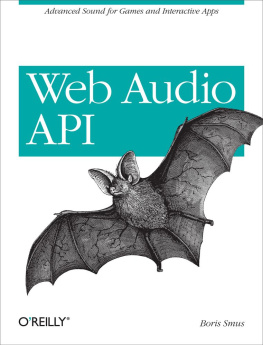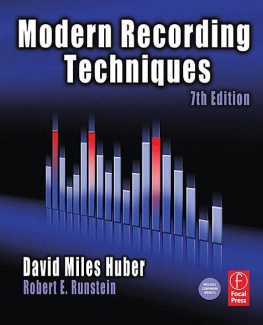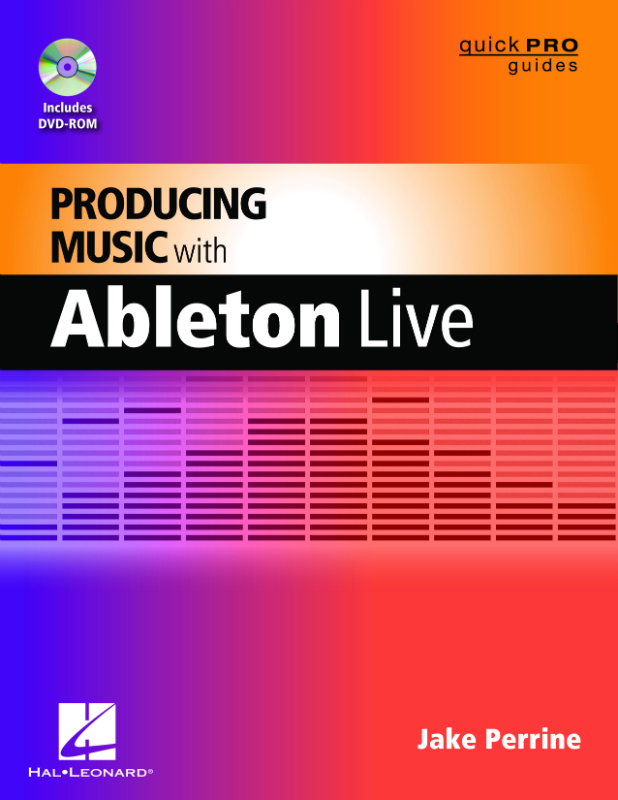
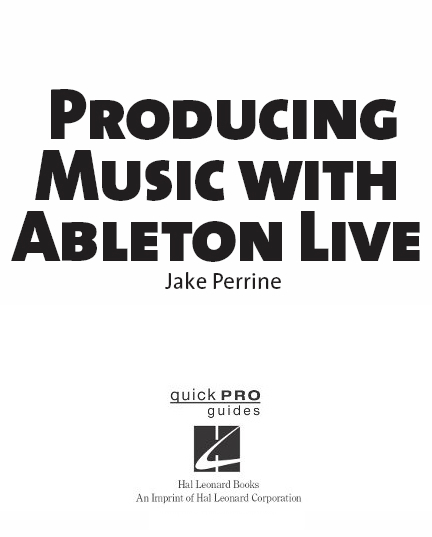
Copyright 2012 by Jake Perrine
All rights reserved. No part of this book may be reproduced in any form, without written permission, except by a newspaper or magazine reviewer who wishes to quote brief passages in connection with a review.
Published in 2012 by Hal Leonard Books
An Imprint of Hal Leonard Corporation
7777 West Bluemound Road
Milwaukee, WI 53213
Trade Book Division Editorial Offices
33 Plymouth St., Montclair, NJ 07042
Book design by Adam Fulrath
Book composition by Bill Gibson
Library of Congress Cataloging-in-Publication Data
Perrine, Jake.
Producing music with Ableton Live / Jake Perrine.
p. cm.
1. Ableton Live. 2. Digital audio editors. I. Title.
ML74.4.A23P47 2011
781.34536--dc23
2011029813
ISBN 978-1-4584-0036-9
www.halleonardbooks.com
Contents
I know the feeling. Symphonies of sound flow through you. If only you had a way to express the rivers of vibration that only you can hear in your head! The size, the impact, the dynamic range, the subtlety, the grandeur, the raw emotion, and the unique blend of timbres that makes you you!
It can be frustrating harboring a wellspring of inspiration with no means to share your unique voice. So, like millions before you, you decide to undertake a lifelong journey: you seek out a point on the horizon that will take you to your goal. Like a painter picking up a paintbrush, you search for the tools that will enable your expression. And that is what has led you to this book. Well done. As Obi-Wan Kenobi once wisely said to Luke, You have just taken your first step into a larger world.
And while this decision to learn a craft is an important stepperhaps the most important stepit is by no means the first step: you have known music and sound all your life, and youve spent countless hours formulating melodies, beats, lyrics, soundscapes, rises and falls, builds and breakdowns, at times to the exclusion of any other thought or activity. This wealth of experience is infinitely valuable. It is the palette of colors that you will draw your inspiration from. Hold onto that. Feed it. Nurture it. Treat it with the utmost respect. Your song is unique in all the universe.
And if you are just starting, there is good news! There has never been a better time to get into electronic-music creation. Never before in the short history of electronic music making have the tools been so powerful, available, inexpensive, and easy to use. Gone are the days of splicing tape and rooms full of gear. With a laptop and some headphones, you can make world-class-caliber music wherever and whenever the inspiration strikes.
There are many different music applications available to choose from. Youve made an excellent choice in selecting Ableton Live! I am not shy about my passion for this programyoull find it on every page of this bookand I hope to inspire the same passion in you. In my humble opinion, Ableton Live represents the best know-how of more than a century of electronic-music makers. It does some very powerful things simply and gracefully in a streamlined interface that is easy to learn, easy to use, and enjoyable to work with.
On the surface, there are many similarities between Live and other multitrack recording and editing packages. Live will definitely do a majority of what those programs can. But in addition to all that standard functionality, Live really shines in its additional ability to work with audio on the fly, or live. As its name implies, it was built with live performance in mind, and in this regard, no other program even comes close.
Another aspect of Live that impresses me is its versatility. Often there are many ways to accomplish similar results within Live, and instead of being locked into one way of doing things, Lives simple yet flexible design allows people to create in their own way. And because there are so many ways to combine Lives features, people are continually discovering new things to do with it! Ive used it for composing, arranging, scoring, jamming with other musicians, remixing, DJing, doing live Looping, art installations, teaching music theory, and sound design for theater, dance, film and videogames. Im sure there are many more uses Ive not yet tried.
Add to that an avid community of users who love to exchange ideas, tips, and techniques! In all my years of music making, Ive never seen a group of users so fanatic about a product or as open about sharing what they know with other users. It really is a true community endeavor. Have a question? Jump on the Ableton forum. Wonder how somebody made that sound? Look it up on YouTube. Looking for a new way to DJ your tunes to a crowd? Download another users templates and controller mappings theyve created. You could spend all your waking hours exploring the wealth of materials available onlinebelieve me, Ive triedand you would have hardly scratched the surface.
So lets get started!
The concepts in this book continue in the companion book Sound Design, Mixing, and Mastering with Ableton Live, and that book picks up right where this one leaves off with very little overlap. Although both books were created to stand on their own, they work best when used together.
The goal of this book is not to explain to you every single feature of the program. You already have Abletons excellent reference manual for that. The goal is to get you making music quickly as possible using the key features that you will use every day, learning specific techniques that will help you reach your goals. When you are ready to delve more deeply, the second book will take you through the remaining, more complex aspects of the program.
If you are just getting started, I recommend moving through this book in a linear fashion. The lessons are sequential, building a song from the ground up, as you learn about Lives features in a hands-on fashion. Each new lesson builds upon the techniques discussed in previous chapters, referencing the previous terms and techniques discussed there. However, if you already have some experience with the program, you can jump in where it feels appropriate, as each exercise has its own corresponding Live Set to get you started at that point.
One feature of these books I am excited to bring to you is that of the appendices. These topics are isolated from the rest of the book because they cover subjects that will be referenced throughout the lessons, and I did not want to impede the focus of the exercises with a bunch of sidebars. If you are unclear about one of the appendix topics referenced in a lesson, take the time to study it.
However, Ive included these appendix topics for another important reason. For more than a decade I have taught audio production concepts, including MIDI, sound design, and Ableton Live to budding new audio engineers. Professional audio engineers make it their job to understand a wide array of concepts, because their careers depend upon it. But in the past decade, I have seen a massive influx of what I like to refer to as The Laptop Producer. This is someone, perhaps like yourself, who does not aim to sit in a studio behind a console recording and mixing bands, but rather wants to use their laptop and perhaps a few controllers to make their own music. Laptop Producers do not need to now how to calibrate a 2-inch analog tape machine, but there are a few key audio-related concepts that do affect them that they often have no knowledge about. I get asked questions about these topics, such as frequency and amplitude or sample rate and bit depth, all the time, and while there is a lot of information online about such topics, there is even more misinformation about them So, the appendices are a subset of topics that are not necessarily Ableton Live specific, but will greatly aid you in working with the program and making computer music in general. I have intentionally tried to give you enough depth in these topics so that you can work with them confidently and not be bogged down in a lot of technical detail that wont serve your needs.
Next page
